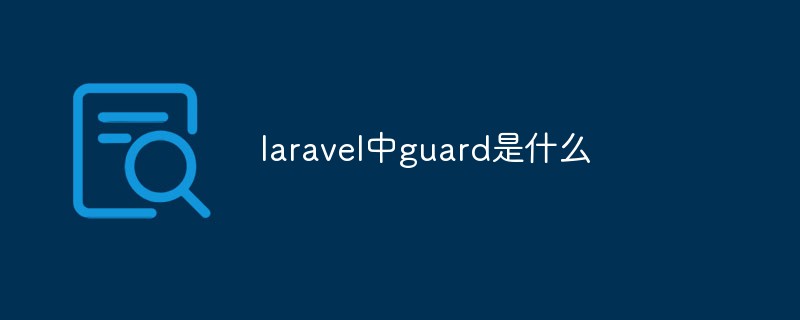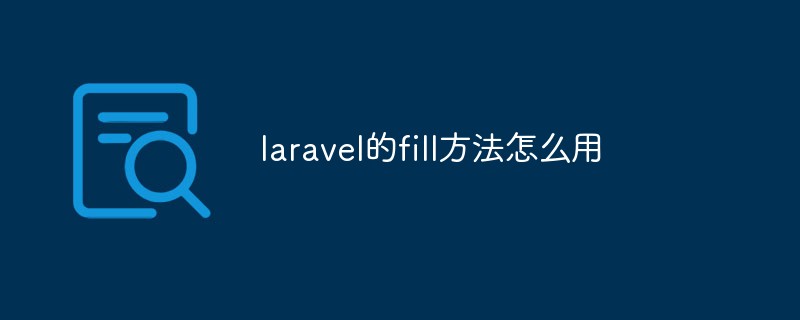 Backend Development
Backend Development PHP Tutorial
PHP Tutorial Using database transactions in Laravel and catching exceptions after transaction failure
Using database transactions in Laravel and catching exceptions after transaction failureDescription
In Laravel, if you want to run a set of operations in a database transaction, you can use the transaction method in the DB facade. If an exception is thrown within a transaction's closure, the transaction will be automatically restored. If the closure runs successfully, the transaction will be automatically committed. You don't need to worry about manually reverting or committing the transaction when using the transaction method:
DB::transaction(function () {
DB::table('users')->update(['votes' => 1]);
DB::table('posts')->delete();
});
Manual operation of transactions
If you want to manually handle the transaction and have full control over the restore or commit operation , you can use the beginTransaction method in the DB facade:
DB::beginTransaction();
You can also use the rollBack method to restore the transaction:
DB::rollBack();
Finally, you can submit the transaction through the commit method :
DB::commit();
Note: The transaction method of the DB facade can also be used to control the query statement builder and Eloquent ORM transactions.
Example
Suppose you want to store a knowledge point in the database. This knowledge point belongs to two different test points at the same time. That is, the two data of test points and knowledge points are many-to-many. relationship, then three tables are needed to implement this data structure:
Knowledge point table wiki:
--------------------------------------- id title content ---------------------------------------
Test point table tag:
------------------- id name -------------------
Test point knowledge point association table wiki_tag_rel
---------------------------------- id tag_id wiki_id ----------------------------------
Now we need to open the transaction to add Wiki data. After the new wiki is successfully added, associate it with the specified test point
(When using the query builder or Eloquent ORM to execute query in laravel , if it fails, Illuminate\Database\QueryException will be returned)
<?php namespace App\Http\Controllers;
use Illuminate\Http\Request;
use Illuminate\Database\QueryException;
use App\Wiki;
class TestController extends Controller
{
//用DB facade的事务方法控制 查询语句构建器的事务
public function storeWiki(Request $request)
{
DB::beginTransaction();
try {
$tagIds = explode(',', $request->get('tag_id'));
$wiki_id = DB::table('wiki')->insertGetId([
'title' => $request->get('title'),
'content' => $request->get('content')
]);
$relationData = [];
foreach($tagIds as $tagId) {
$data = ['wiki_id' => $wiki_id, 'tag_id' => $tagId];
$relationData[] = $data;
}
DB::table('wiki_tag_rel')->insert($relationData);
DB::commit();
} catch(\Illuminate\Database\QueryException $ex) {
DB::rollback();
return \Response::json(['status' => 'error', 'error_msg' => 'Failed, please contact supervisor']);
}
return \Response::json(['status' => 'ok']);
}
//用DB facade的事务方法控制 Eloquent ORM的事务
public function createWiki(array $data)
{
DB::beginTransaction();
try {
$tagIds = explode(',', $data['tag_id']);
$newWiki = Wiki::create([
'title' => $data['title'],
'content' => $data['content']
]);
//Wiki和Tag两个Model使用了belongsToMany建立了多对多的关系
//通过attach方法来附加wiki和tag的关系(写入中间表)
$newWiki->tags()->attach($tagIds);
DB::commit();
} catch(QueryException $ex) {
DB::rollback();
return \Response::json(['status' => 'error', 'error_msg' => 'Failed, please contact supervisor']);
}
return \Response::json(['status' => 'ok']);
}
}
Description
In Laravel, if you want to run a set of operations in a database transaction, you can use the transaction method in the DB facade. If an exception is thrown within a transaction's closure, the transaction will be automatically restored. If the closure runs successfully, the transaction will be automatically committed. You don't need to worry about manually reverting or committing the transaction when using the transaction method:
DB::transaction(function () {
DB::table('users')->update(['votes' => 1]);
DB::table('posts')->delete();
});
Manual operation of transactions
If you want to manually handle the transaction and have full control over the restore or commit operation , you can use the beginTransaction method in the DB facade:
DB::beginTransaction();
You can also use the rollBack method to restore the transaction:
DB::rollBack();
Finally, you can submit the transaction through the commit method :
DB::commit();
Note: The transaction method of the DB facade can also be used to control the query statement builder and Eloquent ORM transactions.
Example
Suppose you want to store a knowledge point in the database. This knowledge point belongs to two different test points at the same time. That is, the two data of test points and knowledge points are many-to-many. relationship, then three tables are needed to implement this data structure:
Knowledge point table wiki:
--------------------------------------- id title content ---------------------------------------
Test point table tag:
------------------- id name -------------------
Test point knowledge point association table wiki_tag_rel
---------------------------------- id tag_id wiki_id ----------------------------------
Now we need to open the transaction to add Wiki data. After the new wiki is successfully added, associate it with the specified test point
(When using the query builder or Eloquent ORM to execute query in laravel , if it fails, Illuminate\Database\QueryException will be returned)
<?php namespace App\Http\Controllers;
use Illuminate\Http\Request;
use Illuminate\Database\QueryException;
use App\Wiki;
class TestController extends Controller
{
//用DB facade的事务方法控制 查询语句构建器的事务
public function storeWiki(Request $request)
{
DB::beginTransaction();
try {
$tagIds = explode(',', $request->get('tag_id'));
$wiki_id = DB::table('wiki')->insertGetId([
'title' => $request->get('title'),
'content' => $request->get('content')
]);
$relationData = [];
foreach($tagIds as $tagId) {
$data = ['wiki_id' => $wiki_id, 'tag_id' => $tagId];
$relationData[] = $data;
}
DB::table('wiki_tag_rel')->insert($relationData);
DB::commit();
} catch(\Illuminate\Database\QueryException $ex) {
DB::rollback();
return \Response::json(['status' => 'error', 'error_msg' => 'Failed, please contact supervisor']);
}
return \Response::json(['status' => 'ok']);
}
//用DB facade的事务方法控制 Eloquent ORM的事务
public function createWiki(array $data)
{
DB::beginTransaction();
try {
$tagIds = explode(',', $data['tag_id']);
$newWiki = Wiki::create([
'title' => $data['title'],
'content' => $data['content']
]);
//Wiki和Tag两个Model使用了belongsToMany建立了多对多的关系
//通过attach方法来附加wiki和tag的关系(写入中间表)
$newWiki->tags()->attach($tagIds);
DB::commit();
} catch(QueryException $ex) {
DB::rollback();
return \Response::json(['status' => 'error', 'error_msg' => 'Failed, please contact supervisor']);
}
return \Response::json(['status' => 'ok']);
}
}
For more articles related to using database transactions in Laravel and capturing exceptions after transaction failures, please pay attention to the PHP Chinese website!
 laravel单点登录方法详解Jun 15, 2022 am 11:45 AM
laravel单点登录方法详解Jun 15, 2022 am 11:45 AM本篇文章给大家带来了关于laravel的相关知识,其中主要介绍了关于单点登录的相关问题,单点登录是指在多个应用系统中,用户只需要登录一次就可以访问所有相互信任的应用系统,下面一起来看一下,希望对大家有帮助。
 一起来聊聊Laravel的生命周期Apr 25, 2022 pm 12:04 PM
一起来聊聊Laravel的生命周期Apr 25, 2022 pm 12:04 PM本篇文章给大家带来了关于laravel的相关知识,其中主要介绍了关于Laravel的生命周期相关问题,Laravel 的生命周期从public\index.php开始,从public\index.php结束,希望对大家有帮助。
 laravel中guard是什么Jun 02, 2022 pm 05:54 PM
laravel中guard是什么Jun 02, 2022 pm 05:54 PM在laravel中,guard是一个用于用户认证的插件;guard的作用就是处理认证判断每一个请求,从数据库中读取数据和用户输入的对比,调用是否登录过或者允许通过的,并且Guard能非常灵活的构建一套自己的认证体系。
 laravel中asset()方法怎么用Jun 02, 2022 pm 04:55 PM
laravel中asset()方法怎么用Jun 02, 2022 pm 04:55 PMlaravel中asset()方法的用法:1、用于引入静态文件,语法为“src="{{asset(‘需要引入的文件路径’)}}"”;2、用于给当前请求的scheme前端资源生成一个url,语法为“$url = asset('前端资源')”。
 实例详解laravel使用中间件记录用户请求日志Apr 26, 2022 am 11:53 AM
实例详解laravel使用中间件记录用户请求日志Apr 26, 2022 am 11:53 AM本篇文章给大家带来了关于laravel的相关知识,其中主要介绍了关于使用中间件记录用户请求日志的相关问题,包括了创建中间件、注册中间件、记录用户访问等等内容,下面一起来看一下,希望对大家有帮助。
 laravel中间件基础详解May 18, 2022 am 11:46 AM
laravel中间件基础详解May 18, 2022 am 11:46 AM本篇文章给大家带来了关于laravel的相关知识,其中主要介绍了关于中间件的相关问题,包括了什么是中间件、自定义中间件等等,中间件为过滤进入应用的 HTTP 请求提供了一套便利的机制,下面一起来看一下,希望对大家有帮助。
 laravel路由文件在哪个目录里Apr 28, 2022 pm 01:07 PM
laravel路由文件在哪个目录里Apr 28, 2022 pm 01:07 PMlaravel路由文件在“routes”目录里。Laravel中所有的路由文件定义在routes目录下,它里面的内容会自动被框架加载;该目录下默认有四个路由文件用于给不同的入口使用:web.php、api.php、console.php等。
 laravel的fill方法怎么用Jun 06, 2022 pm 03:33 PM
laravel的fill方法怎么用Jun 06, 2022 pm 03:33 PM在laravel中,fill方法是一个给Eloquent实例赋值属性的方法,该方法可以理解为用于过滤前端传输过来的与模型中对应的多余字段;当调用该方法时,会先去检测当前Model的状态,根据fillable数组的设置,Model会处于不同的状态。


Hot AI Tools

Undresser.AI Undress
AI-powered app for creating realistic nude photos

AI Clothes Remover
Online AI tool for removing clothes from photos.

Undress AI Tool
Undress images for free

Clothoff.io
AI clothes remover

AI Hentai Generator
Generate AI Hentai for free.

Hot Article

Hot Tools

EditPlus Chinese cracked version
Small size, syntax highlighting, does not support code prompt function

VSCode Windows 64-bit Download
A free and powerful IDE editor launched by Microsoft

Dreamweaver Mac version
Visual web development tools

MinGW - Minimalist GNU for Windows
This project is in the process of being migrated to osdn.net/projects/mingw, you can continue to follow us there. MinGW: A native Windows port of the GNU Compiler Collection (GCC), freely distributable import libraries and header files for building native Windows applications; includes extensions to the MSVC runtime to support C99 functionality. All MinGW software can run on 64-bit Windows platforms.

PhpStorm Mac version
The latest (2018.2.1) professional PHP integrated development tool





